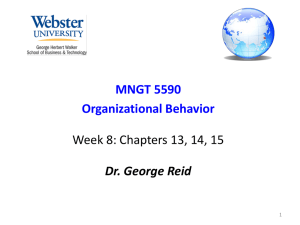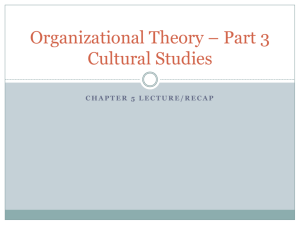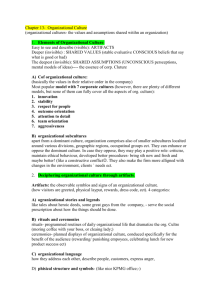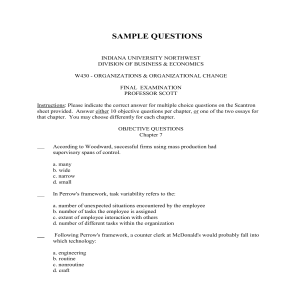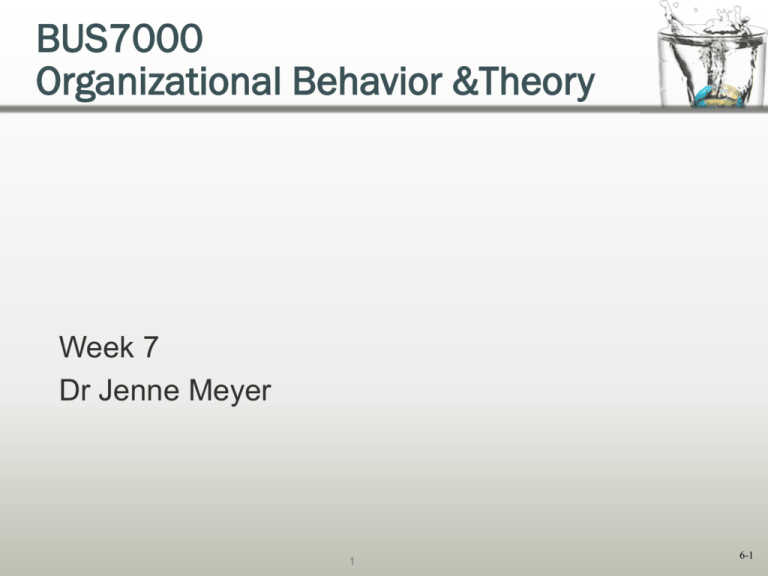
BUS7000
Organizational Behavior &Theory
Week 7
Dr Jenne Meyer
1
6-1
Article Analysis
2
13-2
Designing
Organizational
Structures
McGraw-Hill/Irwin
Copyright © 2013 by The McGraw-Hill Companies, Inc. All rights reserved.
Merritt’s Bakery’s Evolving
Organizational Structure
Merritt’s Bakery has grown
over the years, and
throughout this growth the
Tulsa, Oklahoma, company
has adapted its
organizational structure.
13-4
Organizational Structure Defined
•
Division of labor and patterns
of coordination,
communication, workflow,
and formal power that direct
organizational activities
•
Relates to many OB topics
(e.g. job design, teams,
power, work standards,
information flow)
13-5
Division of Labor
Subdividing work into separate jobs assigned
to different people
Division of labor is limited by ability to
coordinate work
Potentially increases work efficiency
Necessary as company grows and work
becomes more complex
13-6
Coordinating Work Activities
1.
Informal communication
• Sharing information, forming common mental
models
• Good for flexibility, nonroutine and ambiguous
situations
• Easiest in small firms
• Larger firms apply informal communication through
- Liaison roles
- Integrator roles
- Concurrent engineering
13-7
Coordinating Work Activities
2.
Formal hierarchy
• Direct supervision
• Assigns legitimate power to manage others
• Necessary in most firms, but has problems
3.
Standardization
• Standardized processes (e.g., job descriptions)
• Standardized outputs (e.g., sales targets)
• Standardized skills (e.g., training)
13-8
Elements of Organizational
Structure
Departmentalization
Span of
Control
Elements of
Organizational
Structure
Formalization
Centralization
13-9
KenGen’s Flatter Structure
KenGen, Kenya’s leading electricity
generation company, reduced its
hierarchy from 15 layers to just 6
layers. “This flatter structure has
reduced bureaucracy and it has also
improved teamwork,” explains
KenGen executive Simon Ngure.
13-10
Span of Control
Number of people directly reporting
to the next level
• Related to coordination through direct
supervision
Wider span of control possible
when:
1. Other coordinating mechanisms are
present
2. Routine tasks
3. Low employee interdependence
13-11
Tall vs Flat Structures
As companies grow, they:
• Build a taller hierarchy
• Widen span, or both
Problems with tall hierarchies
• Overhead costs
• Worse upward information
• Focus power around managers, so
staff less empowered
13-12
Centralization and Decentralization
Centralization -- Formal
decision making authority is
held by a few people, usually
at the top
Decentralization increases as
companies grow
Varying degrees of
centralization in different
areas of the company
Production
Information
Systems
Sales
Upper Mgt
Upper Mgt
Upper Mgt
Middle Mgt
Middle Mgt
Middle Mgt
Supervisory
Supervisory
Supervisory
Front line
Front line
Front line
• Example: sales decentralized;
info systems centralized
= locus of decision making authority
13-13
Formalization
The degree to which organizations standardize
behavior through rules, procedures, formal
training, and related mechanisms.
Formalization increases as firms get older,
larger, and more regulated
Problems with formalization
•
•
•
•
Reduces organizational flexibility
Discourages organizational learning/creativity
Reduces work efficiency
Increases job dissatisfaction and work stress
13-14
TAXI’s Organic Structure
TAXI, Canada’s creative agency of
the decade, has an organic
structure that relies on small
teams, low formalization, and
decentralized decision making. “We
needed a flexible infrastructure, able
to move with the pace of change,”
says co-founder Paul Lavoie (right in
photo with CEO Rob Guenette).
13-15
Mechanistic vs. Organic Structures
Mechanistic Structure
• Narrow span of control
• High formalization
• High centralization
Organic Structure
• Wide span of control
• Low formalization
• Decentralized decisions
13-16
Effects of Departmentalization
Specifies how employees and their activities are
grouped together
Three functions:
1. Establishes chain of command
2. Creates common mental models, measures of
performance, etc
3. Encourages staff to coordinate through informal
communication
13-17
Functional Organizational Structure
Organizes employees around specific knowledge
or other resources (e.g., marketing, production)
CEO
Finance
Production
Marketing
13-18
Evaluating Functional Structures
Benefits
• Economies of scale
• Supports professional identity and career paths
• Easier supervision
Limitations
• More emphasis on subunit than organizational
goals
• Higher dysfunctional conflict
• Poorer coordination -- requires more controls
13-19
Divisional Structure
Organizes employees around outputs,
clients, or geographic areas
CEO
Healthcare
Lighting
Products
Consumer
Lifestyle
13-20
Divisional Structure
Different forms of divisional structure
• Geographic structure
• Product structure
• Client structure
Best form depends on environmental
diversity or uncertainty
13-21
Globally Integrated Enterprise
Fewer geographic divisions because:
• Less need for local representation
• Reduced geographic variation
• More global clients
Globally integrated enterprise
• Connects work processes around the world rather
than replicating them within each country or region
• Functional heads are geographically distributed
• Firm’s “home” country is no longer focus of
business
13-22
Evaluating Divisional Structures
Benefits
• Building block structure -- accommodates growth
• Focuses on markets/products/clients
Limitations
• Duplication, inefficient use of resources
• Specializations are dispersed--silos of knowledge
• Revising divisional structure emphasis produces
politics and conflict among executives
13-23
Team-Based Structure
Self-directed work teams
Teams organized around work processes
Typically organic structure
Usually found within divisionalized structure
13-24
Evaluating Team-Based Structures
Benefits
• Responsive, flexible
• Lower admin costs
• Quicker, more informed decisions
Limitations
•
•
•
•
•
Interpersonal training costs
Slower during team development
Role ambiguity increases stress
Problems with supervisor role changes
Duplication of resources
13-25
Matrix Structure (Project-based)
Employees ( ) are temporarily assigned to a specific
project team and have a permanent functional unit
CEO
Game1
Project Leader
Game2
Project Leader
Game3
Project Leader
Art Dept
Leader
Software
Dept Leader
Audio Dept
Leader
13-26
Evaluating Matrix Structures
Benefits
•
•
•
•
•
Uses resources and expertise effectively
Improves communication, flexibility, innovation
Focuses specialists on clients and products
Supports knowledge sharing within specialty
Solution when two divisions have equal importance
Limitations
• Increases goal conflict and ambiguity
• Two bosses dilutes accountability
• More conflict, organizational politics, and stress
13-27
Network Organizational Structure
Alliance of firms
creating a product or
service
Product
development
partner
(France)
Call center
partner
(Philippines)
Core
Firm
(USA)
Supporting firms
beehived around a
“hub” or “core” firm
Package
design
partner
(UK)
Accounting
partner
(USA)
Assembly
partner
(China)
13-28
Evaluating Network Structures
Benefits
• Highly flexible
• Potentially better use of skills and technology
• Not saddled with same resources for all products
Limitations
• Exposed to market forces
• Less control over subcontractors than in-house
13-29
External Environment & Structure
Dynamic
• High rate of change
• Use team-based, network, or
other organic structure
Complex
• Many elements (such as
stakeholders)
• Decentralize
Stable
• Steady conditions,
predictable change
• Use mechanistic structure
Simple
• Few environmental elements
• Less need to decentralize
13-30
External Environment & Structure
(con’t)
Diverse
• Several products, clients,
regions
• Use divisional form aligned
with the diversity
Hostile
• Competition and resource
scarcity
• Use organic structure for
responsiveness
Integrated
• Single product, client, place
• Use functional structure, or
geographic division if global
Munificent
• Plenty of resources and
product demand
• Less need for organic
structure
13-31
Effects of Organizational Size
As organizations grow, they have:
More division of labor (job specialization)
Greater use of standardization
More hierarchy and formalization
More decentralization
13-32
Technology and Structure
Technology refers to mechanisms or
processes by which an organization turns out
its product or service
Two contingencies:
• Variability -- the number of exceptions to standard
procedure that tend to occur.
• Analyzability -- the predictability or difficulty of the
required work
13-33
Organizational Strategy
Structure follows strategy
• Strategy points to the environments in which the
organization will operate
• Leaders decide which structure to apply
Innovation strategy
• Providing unique products or attracting clients who
want customization
Cost leadership strategy
• Maximize productivity in order to offer competitive
pricing
13-34
Organizational
Culture
McGraw-Hill/Irwin
Copyright © 2013 by The McGraw-Hill Companies, Inc. All rights reserved.
Facebook’s Organizational Culture
Facebook has been able to
maintain a strong corporate
culture even as it expands
globally. “Maintaining culture is
one of the top priorities we
have as a company,” says
Sarah Smith (shown in this
photo), head of Facebook’s
operations in Austin, Texas.
13-36
Organizational Culture Defined
The basic pattern of shared
values and assumptions
shared within the
organization.
Defines what is important
and unimportant.
Company’s DNA—invisible,
yet powerful template that
shapes employee behavior
13-37
Artifacts of
organizational
culture
Elements of
Organizational
Culture
Organizational
culture
13-38
14-38
Content of Organizational Culture
The relative ordering of values.
• A few dominant values
• Example: Facebook – creative, proactive, risk-oriented
Problems with measuring org culture
• Oversimplifies diversity of possible values
• Ignore shared assumptions
• Adopts an “integration” perspective
An organization’s culture is fuzzy:
• Diverse subcultures (“fragmentation”)
• Values exist within individuals, not work units
13-39
Organizational Culture Profile
Org Culture
Dimensions
Dimension Characteristics
Innovation
Experimenting, opportunity seeking, risk taking, few
rules, low cautiousness
Stability
Predictability, security, rule-oriented
Respect for people
Fairness, tolerance
Outcome
orientation
Action oriented, high expectations, results oriented
Attention to detail
Precise, analytic
Team orientation
Collaboration, people-oriented
Aggressiveness
Competitive, low emphasis on social responsibility
Source: O’Reilly et al (1991)
13-40
Organizational Subcultures
Dominant culture -- most widely shared
values and assumptions
Subcultures
• Located throughout the organization
• Can enhance or oppose (countercultures) firm’s
dominant culture
Two functions of countercultures:
• provide surveillance and critique, ethics
• source of emerging values
13-41
Artifacts: Stories and Legends
Social prescriptions of desired (or
dysfunctional) behavior
Provides a realistic human side to
expectations
Most effective stories and legends:
• Describe real people
• Assumed to be true
• Known throughout the organization
• Are prescriptive
13-42
Artifacts of Organizational Culture
•
Observable symbols and signs
of culture
•
Physical structures,
ceremonies, language, stories
•
Maintain and transmit
organization’s culture
•
Need many artifacts to
accurately decipher a
company’s culture
13-43
Artifacts: Rituals and Ceremonies
Rituals
• programmed routines
• (e.g.., how visitors are greeted)
Ceremonies
• planned activities for an audience
• (e.g.., award ceremonies)
13-44
Artifacts: Organizational Language
Words used to address people, describe
customers, etc.
Leaders use phrases and special vocabulary
as cultural symbols
Language also found in subcultures
13-45
Artifacts: Physical
Structures/Symbols
•
•
Building structure -- may shape and reflect culture
Office design conveys cultural meaning
• Furniture, office size, wall hangings
Courtesy of Microsoft Corp.
13-46
Organizational Culture Strength
How widely and deeply employees hold the
company’s dominant values and
assumptions
Strong cultures exist when:
• most employees understand/embrace the
dominant values
• values and assumptions are institutionalized
through well-established artifacts
• culture is long lasting -- often traced back to
founder
13-47
Functions of Strong Corporate
Cultures
Culture strength
advantages depend on:
• Environment fit
• Not cult-like
• Adaptive culture
Functions of
Strong Cultures
• Control system
• Social glue
• Sense-making
Organizational
Outcomes
• Org performance
• Employee well-being
13-48
Contingencies of Organizational
Culture & Performance
Organizational culture strength moderately
predicts organizational performance
Need to consider contingencies:
1. Ensure culture-environment fit
2. Avoid corporate “cult” strength
3. Create an adaptive culture
13-49
Organizational Culture Assimilation
in the Southwest--AirTran Merger
Organizational culture assimilation practices helped
AirTran Airways employees understand and embrace the
Southwest Airlines culture, known as the “Southwest
Way.” Southwest’s success and its popular culture
assisted this assimilation process.
13-50
Merging Cultures: Bicultural Audit
Part of due diligence in merger
Minimizes cultural collision by diagnosing companies
Three steps in bicultural audit:
1. Identify cultural artifacts
2. Analyze data for cultural conflict/compatibility
3. Identify strategies and action plans to bridge cultures
13-51
Merging Organizational Cultures
Assimilation
Deculturation
Acquired company embraces acquiring
firm’s cultural values
Acquiring firm imposes its culture on
unwilling acquired firm
Integration
Cultures combined into a new composite
culture
Separation
Merging companies remain separate with
their own culture
13-52
Changing/Strengthening
Organizational Culture
13-53
Changing/Strengthening
Organizational Culture
Actions of Founders/Leaders
• Org culture sometimes reflects the founder’s
personality
• Transformational leaders can reshape culture
-- organizational change practices
Aligning Artifacts
• Artifacts keep culture in place
• e.g., create memorable events,
communicating stories, transferring
culture carriers
13-54
Changing/Strengthening
Organizational Culture
Introducing Culturally Consistent
Rewards
• Rewards are powerful artifacts – reinforce
culturally-consistent behavior
Attracting, Selecting, Socializing
Employees
• Attraction-selection-attrition theory
• Socialization practices
13-55
Attraction-Selection-Attrition Theory
Organizations become more homogeneous
(stronger culture) through:
• Attraction -- applicants self-select and weed out
companies based on compatible values
• Selection -- applicants selected based on values
congruent with organization’s culture
• Attrition -- employees quit or are forced out when
their values oppose company values
13-56
Lindblad’s Shipshape Socialization
As part of its socialization process, adventure cruise
company Lindblad Expeditions shows applicants a video
program with a realistic preview of what it’s like to work
onboard.
13-57
Organizational Socialization Defined
The process by which individuals learn the values,
expected behaviors, and social knowledge necessary to
assume their roles in the organization.
13-58
Socialization: Learning &
Adjustment
Learning Process
• Newcomers make sense of the organization’s
physical, social, and strategic/cultural dynamics
Adjustment Process
• Newcomers need to adapt to their new work
environment
- New work roles
- New team norms
- Newcomers with diverse experience adjust better
13-59
Stages of Socialization
Pre-Employment
Stage
Encounter
Stage
Role
Management
• Outsider
• Newcomer
• Insider
• Gathering
information
• Testing
expectations
• Changing roles
and behavior
• Forming
psychological
contract
• Resolving
conflicts
13-60
Improving Organizational
Socialization
Realistic job preview (RJP)
• A balance of positive and negative information
about the job and work context
Socialization agents
• Supervisors – technical information, performance
feedback, job duties
• Co-workers – ideal when accessible, role models,
tolerant, and supportive
13-61

